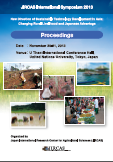Novel Food Technologies to Provide Better Quality and Value-added Foods for Consumers in Asia

Variable food life and increasing competition require food industry to have more technological
innovation in food processing. The past decade has seen a tremendous development of food technology
such as membrane technology, extrusion cooking, high pressure cooking, ohmic heating (OH) and
superheated steam (SHS) cooking which enable the production of new food products with quality,
previously unrealized by existing techniques. Research and Development associations were established to
assist extrusion cooking and high pressure cooking by private enterprises at a call from the Ministry of
Agriculture, Forestry and Fisheries. These R&D associations have stimulated their researches greatly and
new foods and feeds have been developed and tested in the market.
For example, a twin screw extruder is catching the attention of food manufacturers because of its high
capability in material transportation as compared with a single screw type. The better mixing, kneading,
heat exchange and self-cleaning functions of twin screw extruders also provide an incentive to develop
this food technology and to iron out the difficulties associated with the single screw type. Recent
development of twin screw extruders provides us with new applications to various food processing,
especially to better textured protein products and wet processes.
High pressure has tended to receive less attention than heat in the context of food processing. This is
obvious because the test apparatuses for food research have been developed relatively late. In addition, the
high pressure range hardly has any relevance to food processing. However, recent advances in equipment
are expected to make this technology more feasible for food companies, with the understanding that
pressure can be applied momentarily and equally applied to any form and composition without leaving
any physical damage or any pressure energy after its release. The technique is applying hydrostatic
pressure of several hundred MPa on foods for the purpose of sterilization, denaturation of proteins, control
of enzyme and chemical reactions, homogeneous defrosting at low temperature and others. High pressure
cooking is based on cold isostatic pressing and achieved by applying high pressure to the foods through
the surrounding water or liquids.
Ohmic heating (OH) is defined as a process wherein electric current is passed through materials with
the primary purpose of heating them, and its capital investment will not be so high. In OH, there is no
need to transfer heat through solid-liquid interfaces or inside solid particles once the energy is dissipated
directly into the foods. A large number of actual and potential applications exist for OH, including
blanching, evaporation, dehydration, fermentation, extraction, sterilization and heating of foods to serving
temperature. In addition to the heating promotion, research data strongly suggests that the applied electric
field under OH causes electroporation of cell membranes. The cell electroporation is defined as the
formation of pores in cell membranes due to the presence of an electric field and as a consequence, the
permeability of the membrane is enhanced and material diffusion throughout the membrane is achieved
by electro-osmosis. These phenomena are very attractive to improve the rate and efficiency of solid-liquid
separation such as the juice preparation and will have high potential to the nonthermal sterilization.
Superheated steam (SHS) is a clear, colorless gas obtained by heating ordinary steam at 100°C to a
higher temperature under normal pressure. The properties of superheated steam approximate those of a
perfect gas rather than of a vapor. With its high heat transfer capabilities, it is applied to a wide range of
fields including food preparation methods such as roasting, grilling and baking. These phenomena have
caught strong interest from the researchers and home appliance makers are competing to sell microwave
ovens with SHS.
Meanwhile, what is important to remember is that food safety is an essential public health and trade
issue. It is a major concern for consumers, industry and government. As such, the need to address it
throughout food supply chains is compelling. The importance of food safety has significantly increased in recent years following a series of global events associated with incidents of contamination and outbreaks
like contamination Escherichia coli O157:H7, dioxin, MCPD, mad cow disease and foot and mouth
disease.
Advancement in the field of food science and technology has stimulated the growth of the food industry.
However, it has also contributed to the increase in the likelihood of health hazards. Changes in consumers’
tastes and preferences that result in the influx of a wide variety of foods greatly impose on the limited
resources to ensure food safety. All these have immense impositions on the national governments to
ensure food safety both for public health as well as for consumer health protection.
Recent rapid development of fluorescence finger print technique is regarded as nondestructive and
quick method and expected to provide us the answer to the above issues.
This presentation will take up a few examples of recent research or industrial achievements in some
food technologies in Japan.
| 刊行年月日 | |
|---|---|
| 作成者 | Akinori Noguchi |
| 著者キーワード |
Extrusion cooking High pressure cooking Ohmic heating Superheated steam Fluorescence finger print technique |
| 公開者 | Japan International Research Center for Agricultural Sciences |
| オンライン掲載日 | |
| 号 | 2013 |
| 開始ページ | 110 |
| 終了ページ | 124 |
| 権利 | Japan International Research Center for Agricultural Sciences |
| 言語 | eng |
